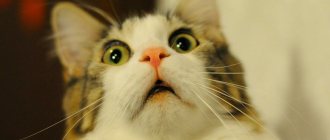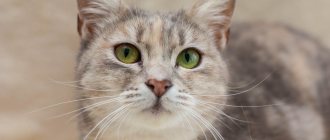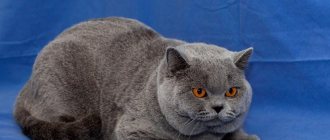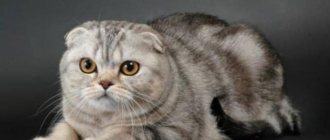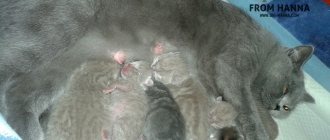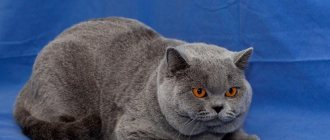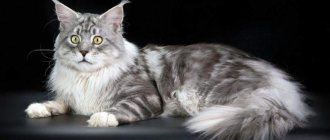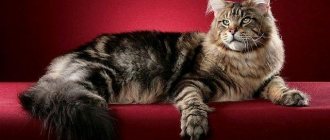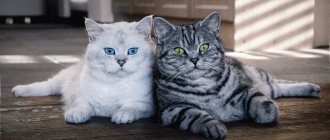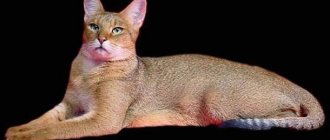The offspring of mixed feline “marriages” are often called designer animals. Through experiments, breeders try to obtain some unique appearance features or coat colors, and sometimes even hope to create a new breed group. However, the British Shorthair/Scottish Fold cross has a different story.
These cats are blood relatives and are very similar in appearance. But the planned matings between them are carried out for another reason. Let's find out what kind of mestizos are born from British and Scottish breeds.
Is it possible to crossbreed a Briton and a Scot?
All cat breeds are allowed to breed with each other. They have the same chromosomal map (19 elements from each parent) and a common genetic sex pattern (male cats have XY, and female cats have XX). In each individual case, breeders pursue a specific goal. The cross between a British and a Scot is very significant in this context. To understand the logic of action, you will have to look at the history of these two breeds.
The native English Shorthair cat has a long pedigree line. Perhaps her ancestors came to the islands 10 centuries ago and adapted perfectly to their new conditions. Like all old species, they are not subject to hereditary genetic changes and demonstrate good health and enviable longevity.
The first Scottish Folds were discovered in 1961, when a white cat with a natural ear mutation appeared on a farm in the central part of the country. Her ears folded forward funny and covered the ear canal area. It was not possible to find out whether the unique variety was a descendant of the British breed, a mixture or a simple country cat. From her single kitten an entire population developed.
Fold cats were crossed with British and American Shorthairs, as breeders had no other options. At the first stage, the genetic consequences of the crossbred appeared, due to which the kittens developed a disease of the musculoskeletal system (osteochondrodysplasia).
It was possible to improve the health of hybrids through interbreed matings. A mixture of a British cat and a Scottish fold turned out to be viable only in the heterozygous form. This means that one of the animals must carry the genes for straight ears (these were aboriginal English), and the other may have fold ears. True, children inherit a characteristic trait in the proportion of 50x50 (they will have both lop-eared and straight-eared children). A pair of parents with the same ear structure (homozygous) gives birth to sick kittens.
Thanks to this interbreeding, two global problems were solved: the formation of a unique appearance and the production of healthy offspring capable of continuing the bloodline.
Who can a Scottish Fold cat mate with?
The Scottish Fold cat can mate with any member of the cat family.
It is noteworthy that these animals received lop ears during selection due to a mutation, which resulted in the formation of an anomaly of the ear cartilage, which is unable to hold the ears in an upright position.
Standards
- The head should be round, with a wide nose, expressive round and wide-set eyes.
- Rounded mustache pads, clearly defined and strong jaws and chin.
Rules for mating
Puberty in females occurs around the eighth month of life. A cat will be ready for mating no earlier than one and a half or two years, depending on the individual characteristics of the animal’s body. Mating during the first heat is strictly prohibited due to the unpreparedness of the young female’s body.
Puberty in females occurs in the eighth month of life.
It is recommended to begin this process during the second, or even third, heat cycle. The third and fourth days of estrus are considered favorable. Before the event, the cat must have all the necessary vaccinations and deworming. The first mating should occur with a strong and experienced male.
What does a Scotsman look like?
The breed of fold cats is divided into two breeding branches.
A cross between British and Scottish Shorthairs is characterized by the following characteristics:
- Smooth lines of the body, low legs and rounded powerful paws.
- Thick and short fur.
- More than 200 types of colors, which are divided into 3 groups: solid, tortoiseshell, tabby.
- The eyes are large, round, widely spaced. Their color should be in harmony with the coat color. Whites may have a blue tint or heterochromia.
The American branch differs from the European:
- The muzzle is round, but the cheeks are less puffy.
- A more refined structure - the body is not as stocky as that of the “Europeans”.
- Among the American descendants of fold-eared cats, there are many animals with a modified structure of the auricle - the auditory canal is completely closed.
This is interesting! Thanks to the American type, it was possible to solve the problem of a short and partially immobile tail in mixed-breed Scottish and British cats. This pathology was caused by the influence of the Fd gene on the intervertebral discs and joint structure. As soon as breeders found the opportunity to produce normal long-tailed cats, the problem of the health of the musculoskeletal system receded into the background.
To knit or not
Scots must be prepared especially carefully for mating, since fold-eared cats and the same fold-eared cats should not be mated under any circumstances. Such thoughtless mating can lead to deformity of future offspring at the genetic level:
- Bone defects,
- Vertebral fusion,
- Thickening of the tail
- Problems with the musculoskeletal system.
In this case, drooping ears will be rare; most kittens will have straight ears. But the babies will be born healthy.
Why do breeders not recommend breeding British and Scottish dogs?
The British breed has a strong gene
Do not forget that the British breed has a strong gene that is responsible for the cat’s body weight. British cats are very large, they pass this feature on by inheritance. Kittens will be born large, labor is difficult, and complications often occur.
The skeletal system cannot be rebuilt and cannot withstand the load of the large size of the British breed gene.
This seems very strange. But what about the struggle for the purity of the breed? The main thing is that the offspring born do not have any abnormalities, are full-fledged and healthy.
British mating
A number of rules must be followed for the successful birth of kittens.
It's a different matter with the British cat breed. Here everything is exactly the opposite. A cat of British origin can only be bred with an equally British cat. Otherwise, when recording in the pedigree, the kittens born from such a mating will not receive recognition as belonging to the British breed.
Now we can talk about purebred. Beautiful physique, large plush kittens will already find their owners at birth. Such cute babies will be taken apart with joy, although the price will be quite high. This breed is beautiful, friendly to people, and pleasant to talk to.
What is the health of a half-breed cat?
Geneticists were able to identify the causes of hereditary transmission of osteochondrodysplasia in cats and they found a formula to combat this disease. This solved the main problem with the health of kittens in a mixture of British and Scottish breeds. The main diseases of Scottish and British mixed breeds are associated with problems of advanced cat age - these are pathologies of the kidneys and heart. White cats may have decreased or completely absent hearing, which is also a standard threat for representatives of any breed.
As for joints and vertebrae, their damage in adulthood occurs extremely rarely. If a Scottish Fold cat mix did not have these signs in childhood, then later in life he is most likely safe.
Important! The average life expectancy of Scots is 10-15 years.
When is crossing possible?
Sometimes crossbreeding between these breeds occurs. Some owners simply do not have the necessary information about the consequences, others do not have a suitable match in mind. Often the British and the Scots live in the same house, and it is difficult to keep track of them.
In rare cases, knitting is allowed only as experiments in breeding clubs. It is mandatory to make an entry in a special journal and present a pedigree. The entire brood is then supervised by club members.
Conclusions: according to the rules, you only need to breed representatives of your own breed. If for some reason this is not possible, seek help from an experienced felinologist. It will help solve the problem with minimal harm to the kittens. Avoid amateurs who claim they can guarantee excellent results.
Source
Other mestizos options
In the breeding of domestic cats, a standard practice has developed in which interesting breeds (in terms of appearance, coat, color or health) take part in the selection of new species, and sometimes are crossed with others to expand their arsenal of capabilities.
Crossing the British and Siamese breeds
A cross between a British cat and a Siamese cat is an example in which native English pets received a new appearance.
The gray-blue color is traditional for the British. However, as a result of evolution and inbreeding with Persians, Angoras and exotics, the cat’s fur coat acquired new shades of solid colors (black, blue, red), as well as two-color combinations, tortoiseshell, smoky and others. At some point, breeders wanted to supplement the arsenal with a unique Siamese color point - an acromelanic mask on the face, ears, paws and the end of the tail.
Read more about Siamese cats in this article.
Towards the middle of the twentieth century, interbreeding was carried out with cats possessing the desired characteristics. As a result, the British received a new color, but at the same time retained the constitution. Later, the color-point color of British cats was recognized by international felinological organizations.
The appearance of such mestizos always bears one of two phenotypes: British or Thai. In the first case, it will be a heavy, powerful cat with rounded lines and a strong musculoskeletal system. In the second - graceful, fit, on high thin legs and with a long flexible tail.
This is interesting! The character of a mestizo combines traits from two breeds - selfishness, pride, and sometimes the aggression of a Briton and the stubbornness of a Siamese. Such a cat will give its owner a serious test of compatibility.
Mixed breed between a British cat and an ordinary cat
Kittens from an ordinary cat and a British cat are most often born when the owner did not take care of the pet. Such a mestizo completely or partially inherits his appearance from his British parent. However, the color of a cross between British and outbred cats directly depends on the genetic map of the producers. A red-haired mother will definitely have equally red sons, and the girls will acquire tortoiseshell colors. Since only the British breed in this pair has slight restrictions on coat color, there can be a lot of color options for kittens.
In character, the outbred line usually takes over - such cats are characterized by loyalty to people, sociability, and responsiveness to affection. The craving for loneliness, traditional for the British, is most pronounced in the first years of life, and almost disappears with age.
A cross between a Scottish Fold and a regular cat
There is no guarantee that with such a parental pair, lop ears are inherited. All breeding programs take into account the Fd gene (fd) as the main tool to achieve the goal.
The first experiments with Scots showed very low results from simple crossing with straight-eared cats. For example, the cat Susie, the ancestor of all Scottish Folds, had only 2 kittens with ear changes in her first litter. Subsequently, breeders were forced to use inbreeding (inbreeding) in order to expand the experimental group by any means. But this led to problems with bones, cartilage and ligaments. The breeders got rid of them only a decade later.
Important! A cross between a mongrel cat and a Scottish Fold will most likely produce ordinary kittens. They can inherit any characteristics except the shape of the ears.
Mixture of Sphynx and Scotsman
Attempts to breed a cross between the Scottish Fold and the Canadian (or Rostov) Sphynx have not yet been crowned with lasting results. Seals are born Scottish or hairless Sphynx cats.
Despite the fact that even the straight-eared Scottish Straights, which also carry the Fd gene, were included in the selection, it has not yet been possible to breed an animal with the external characteristics of both breeds.
Possible problems arising during crossing
Despite the characteristics of each species individually, crossing a British and a Scotsman is not recommended. The mixture obtained in this way has a number of disadvantages. If you mix animals of these two breeds, you get kittens with large and wide-set ears. A mixture cannot compete with its self-sufficient parents. Britons are considered large and heavy cats with strong bones. Scots are characterized by a sweet face and graceful body.
Previously, one breed was bred from another. Over time, after reaching the desired standards, the two varieties continued to be crossed to produce more unique qualities. For example, a breeder wanted to breed a Scotsman with a denser body structure, and change the color of a Briton.
Scottish Fold and British Practice shows that such crossing has many disadvantages. The quality of the offspring's coat deteriorates, and serious problems with the musculoskeletal system appear. This is due to the fact that the Scottish cat has a weaker skeleton, while the British cat has a wide bone. Heaviness combined with weak joints provoked dangerous diseases.
When crossing a Scottish Fold and a British Fold, the resulting fold kittens will be defective. To obtain miniature ears with two or three folds at the fold, a modifier gene is required, which is found in the Scottish breed. The British don't have it, so their ears are not brought to the required standard. They are larger in size and wider in location. Because of this, over time, the lop ear disappears and the ears straighten.
Comments
My tartan was affectionate, but she stroked it anywhere.
She looks a lot like my cat as a child) she took a mongrel on purpose, roughly speaking, so that he would be affectionate, but in reality it doesn’t matter) you can pet him whenever he wants, he’s characteristic) but with the advent of the child he became calmer, he doesn’t touch her, he knows that they’ll piss off)
Why did you decide that the Scots are evil? I have a Scottish Fold - a very affectionate girl, she is only afraid of strangers and hides, but loves her own
I have a “yard” cat, but she behaves like a countess
